Advertisement
Everything you need to cook a mouthwatering Thanksgiving meal, from the bird to sides to dessert
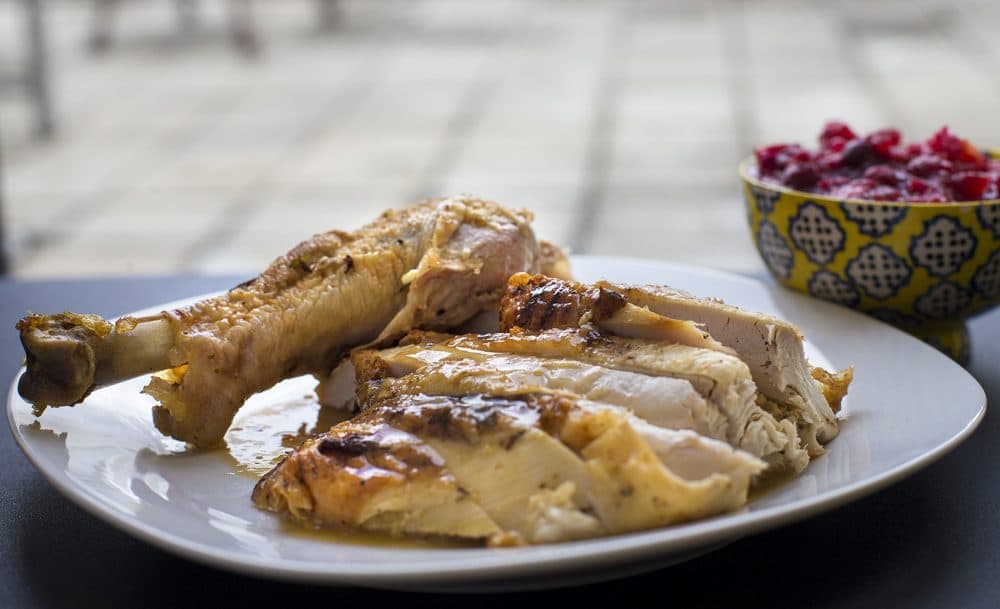
A lot goes into cooking a full Thanksgiving meal.
Every year, our resident chef Kathy Gunst serves up new recipes and tips to help home chefs cook a delicious holiday feast. So, we're looking back on some of Kathy's best Thanksgiving appetizers, sides and turkey tips.
While everything's in the oven
Roasted mushroom soup
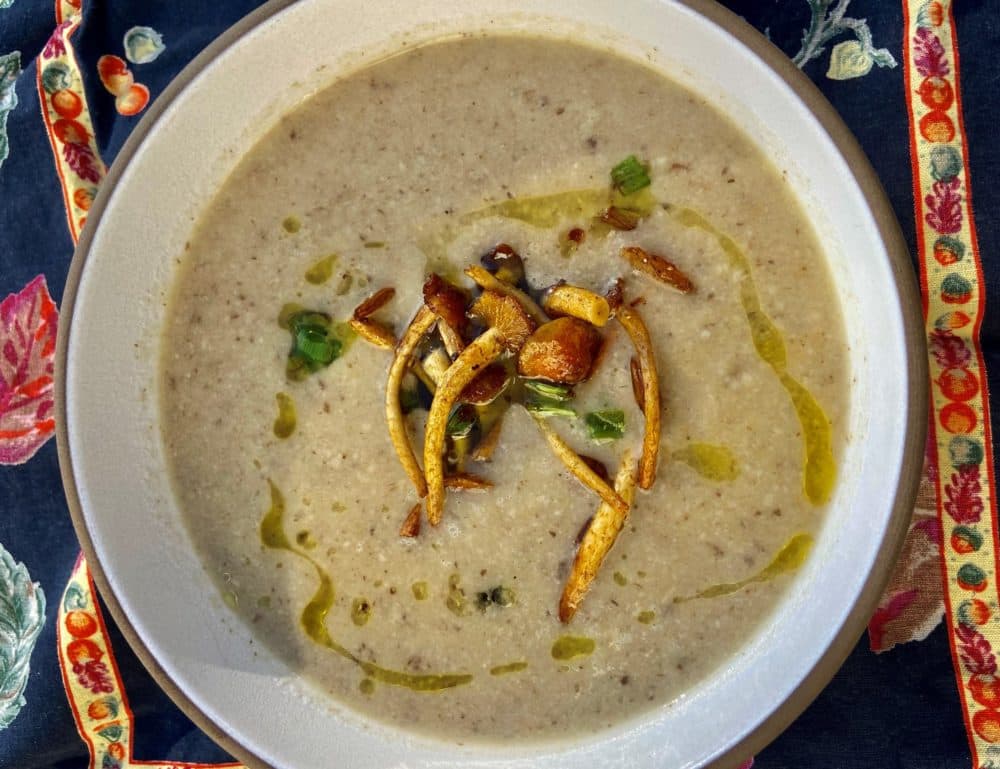
The depth of flavor defies the effort it takes to make this simple vegan soup. Mushrooms are roasted with onions and a touch of fresh ginger and then simmered in vegetable stock. The whole mixture is pureed and that’s it. No dairy. No embellishments. It’s light, while still bursting with big fall flavors. A perfect start to your feast. Of course, you can choose to top the soup with a swirl of heavy cream or yogurt, or a sprinkle of chives or parsley. But you don’t need a thing. The soup can be made up to 3 days ahead of time, freeing you up on Thanksgiving day. Serve very small portions — a demi-tasse or small tea or coffee cup or even a shot glass.
Serves 4 to 6 small portions.
Ingredients
- 2 medium onions, or 1 large, chopped into ½-inch size pieces
- 3 scallions, ends trimmed and chopped, into ½-inch size pieces
- 2 tablespoons fresh ginger, peeled and finely chopped
- 1 pound shiitakes or your favorite mushrooms, coarsely chopped into 1-inch size pieces
- 1 ½ tablespoon olive oil
- Salt and pepper to taste
- 4 cups vegetable stock
Optional garnishes:
- ¼ pound mushrooms, think about using a different variety for contrast, stems trimmed and coarsely chopped
- 1 tablespoon olive oil
- Salt and pepper to taste
- About 2 tablespoons chopped fresh chives and or parsley
- Greek-style yogurt or heavy cream, optional
Instructions
- Make the soup: Preheat the oven to 450 degrees.
- In a medium roasting pan or baking sheet with sides, toss the onions, scallions, half the ginger, mushrooms, olive oil, salt and pepper. Roast on the middle shelf for 15 minutes.
- Meanwhile, heat the stock and the remaining ginger in a medium pot over medium heat until simmering. Scrape everything from the roasting pan into the simmering stock and bring to a boil over high heat. Reduce the heat to low and simmer, covered, for 10 minutes. Taste for seasoning. Puree the soup with an immersion blender or transfer to the bowl of a food processor or blender and whirl until smooth. Reheat and taste for seasoning.
- To make the mushroom garnish: Heat a medium skillet over high heat. Add the oil and then the mushrooms, salt, pepper and chives or parsley. Cook, stirring, for 5 minutes. Top the hot soup with the cooked mushrooms and chives, or with cream or yogurt.
Find more Thanksgiving starters here.
The bird of the hour
Roast turkey with pan dripping gravy
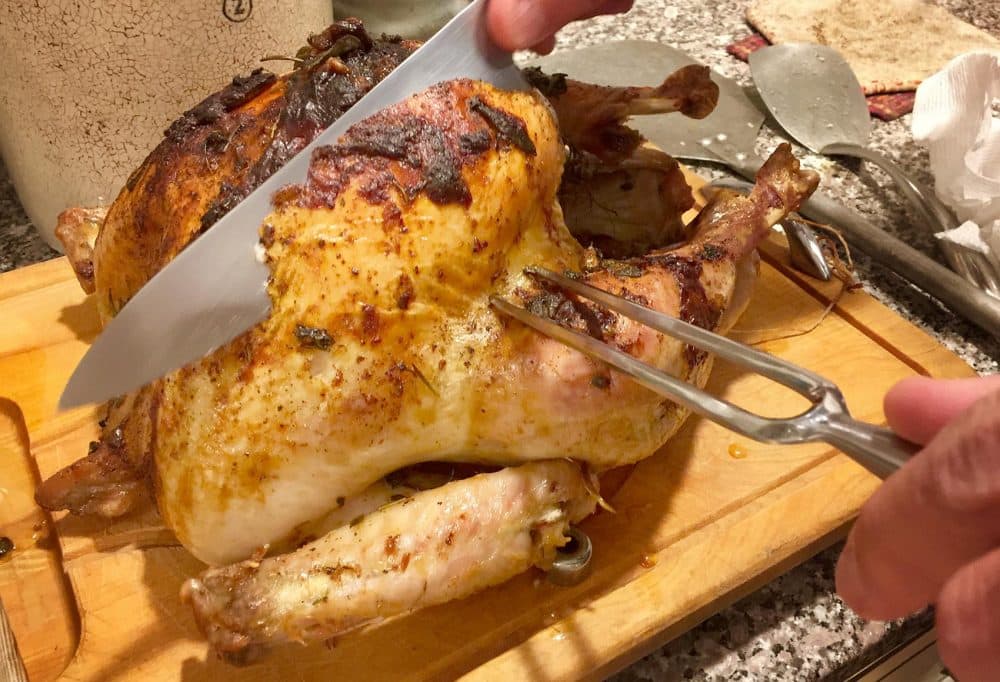
This recipe is for an 18- to 20-pound bird, but can easily work with a smaller one by reducing the cooking time. If you're working with a frozen turkey be sure to defrost in time (see "Frozen Tips" below) and leave time to brine the bird if you like. The turkey should soak in the brine for at least 12 to 24 hours and then it needs to dry out for several hours before roasting.
Turkey ingredients
- One 18- to 20-pound fresh turkey (preferably organic), at room temperature*
- 1 1/2 tablespoons vegetable oil
- Salt and freshly ground black pepper, to taste
- 1 stick butter
- 10 cloves garlic, peeled and left whole
- 2 tablespoon chopped fresh thyme
- 2 tablespoons chopped fresh sage
- Sweet Hungarian paprika
- Your favorite stuffing, optional
- 1 slice bread, optional
- Kitchen string or butcher’s twine
*Room temperature simply means that the bird shouldn’t come straight out of the refrigerator. You don’t want to let it sit around for hours; remove from the refrigerator about one hour before roasting while you make the stuffing. And never stuff a bird until you’re just about to put it in the oven.
Stock and gravy ingredients
- 1 turkey neck, heart and gizzard from the inside of the turkey
- 1/2 cup coarsely chopped fresh parsley
- 2 onions, peeled and quartered
- 2 ribs celery, chopped
- 2 carrots, peeled and chopped
- 6 peppercorns
- 1 bay leaf
- Salt and freshly ground black pepper, to taste
- 2 1/2 tablespoons flour
Instructions
- Defrost the turkey if frozen. Brine the bird if you choose.
- Preheat the oven to 450 degrees. Arrange the oven rack so the bird will fit on the middle shelf without touching the top shelf.
- Clean the bird and remove the neck, giblets, liver and heart, and set aside for the stock/gravy. Pat the bird dry with paper towels. (The liver can be reserved; it is delicious lightly coated in flour and then sautéed in a hot skillet greased with 1 teaspoon of butter for about five to six minutes per side.)
- Use the vegetable oil to lightly grease the bottom of a large roasting pan. Season the turkey with pepper and salt (only if you did not brine the bird), inside the cavity and outside the skin. If stuffing the bird, loosely stuff both the body and neck cavities of the turkey with your choice of stuffing, pressing down but being careful not to overstuff the bird. Use the whole slice of bread as a "door" to keep the stuffing inside the large body cavity; simply press the bread into the cavity as a way of keeping the stuffing inside so it won’t fall out while roasting. Carefully place the bird into the roasting pan, breast side up. If you want to use a roasting rack simply place the bird on the rack and set inside the pan.
- In a medium skillet, heat the butter over low heat. Add the garlic cloves, thyme and sage and let cook two to three minutes until the butter has completely melted, and the garlic is just beginning to turn a light golden brown. Remove from the heat. Using a spoon or a barbecue or pastry brush, brush the skin of the turkey with some of the garlic butter and scatter at least half the garlic cloves around and on top of the bird. Keep the remaining garlic and butter for later basting. Sprinkle the top of the bird with the paprika, salt and pepper. Using a piece of kitchen string, tie the legs together to keep them from touching the sides of the roasting pan; tying the legs also makes for a "neater" looking roasted turkey.
- Place the bird on the middle shelf and roast for 30 minutes. Reduce the heat to 350 degrees and loosely cover the bird with foil. Roast the turkey another 3 1/2 to 4 1/2 hours, about 15 to 20 minutes per pound, depending on the freshness of the bird. (Fresh turkey tends to cook much faster than those that have been frozen. And unstuffed birds will cook even faster so be sure to check the turkey after it’s roasted for 10 minutes per pound.) Baste the bird every hour or so with the remaining garlic and butter and baste with the liquids that have accumulated on the bottom of the roasting pan. Remove the foil for the last hour of roasting time to give the bird a golden brown glaze.
- While the bird is roasting, begin the gravy by making the turkey stock: place the reserved neck, giblets, and heart in a medium saucepan. Add the parsley, onions, celery, carrots, peppercorns, bay leaf, salt and pepper to the pot and cover with about 8 cups cold water. Bring to a boil over high heat, reduce the heat, and let simmer on very low heat for about 1 to 2 hours. This will produce a light turkey stock that will be the basis of your gravy. Taste for seasoning and remove from the heat.
- To test for done-ness: the bird should be a gorgeous golden brown; when you wiggle a drumstick, it should feel slightly loose, and when you pierce the skin directly above the wing, the juice should run clear yellow, and not pink. A meat thermometer placed deep into the breast should read 150 degrees. The bird will keep cooking once it’s removed from the oven so be careful not to overcook it. Gently remove the bird from the roasting pan and place on a serving platter; cover loosely with aluminum foil.
- To finish the gravy, once you’ve removed the bird, place the roasting pan over two burners over moderate heat. (If there seems to be an excessive amount of turkey fat in the bottom of the pan, remove it by tilting the juices to the side and remove with a spoon or baster, being careful not to remove any of the natural juices.) Use a spatula to loosen any bits clinging to the bottom of the roasting pan. Sprinkle on the flour and, using a whisk, mix the flour with the juices in the bottom of the pan. Let cook one minute, stirring, until the paste has come together and is beginning to turn a pale golden color. Pour a little more than half the turkey stock through a sieve into the pan and whisk to create a smooth gravy. Let simmer about five to 10 minutes, until slightly thickened and flavorful. Thin the gravy by adding additional stock as needed. Simmer until the gravy is the desired thickness. Season to taste with salt and pepper. Keep the gravy warm over a low heat, stirring occasionally, until ready to serve.
Advertisement
Find more turkey tips here.
Sides to steal the show
Chestnut and apple stuffed acorn squash with cider glaze

You can use any type of winter squash you like with this dish, but acorn and kabocha, delicata and buttercup work particularly well since they have deep, large cavities for the stuffing. The stuffing can be made a day ahead of time, and the squash can be filled several hours before baking.
This makes a beautiful side dish, but it also would be ideal for any vegetarians at your holiday table.
Serves 2 to 4.
Ingredients
- 1 tablespoon olive oil
- 1 small onion, finely chopped
- Salt and freshly ground black pepper
- 2 tablespoons fresh sage, coarsely chopped
- ½ cup pre-roasted and peeled chestnuts, coarsely chopped (look for them in glass jars and plastic pouches)
- ½ cup Panko or regular breadcrumbs
- 1 small tart apple, peeled, cored and coarsely chopped
- 1 acorn squash about 1 ½ pounds, cut in half, seeds and fibers removed, and very thin slice cut off the rounded outside edge so the squash will sit flat
- 2 tablespoons butter, cut into small cubes
- 1 ½ cups apple cider
- Fresh sage leaves for garnish
Ingredients
- Prepare the filling: in a medium skillet heat the oil over low heat. Add the onion, salt, pepper and half the sage and cook, stirring, for 5 minutes. Add the chestnuts and cook for another 4 minutes, stirring. Remove from the heat and add the panko or breadcrumbs and the apple. Add the remaining sage and taste for seasoning, adding more salt and pepper as needed.
- Preheat the oven to 400 degrees.
- Place the squash in a medium-sized baking or gratin dish. Season the squash with a generous amount of salt and pepper. Divide the stuffing between the two cavities, pushing down and mounding it. If you have extra stuffing you can bake it in a small skillet or baking dish alongside the squash. Dot the top of the filling with 1 tablespoon of the butter cubes and pour 1 cup of the cider on top of the stuffing and squash, letting it drip down the sides and onto the bottom of the pan.
- Bake for 30 minutes. Add the remaining butter on top of the stuffing and pour the remaining ½ cup cider on top. Bake another 30 minutes, or until the squash feels tender when tested with a small, sharp knife or the tines of a fork. Serve hot or room temperature with the sage leaves as a garnish. You can serve them whole or cut in half. Serves 2 to 4.
Gingered cranberry sauce with pineapple and pecans
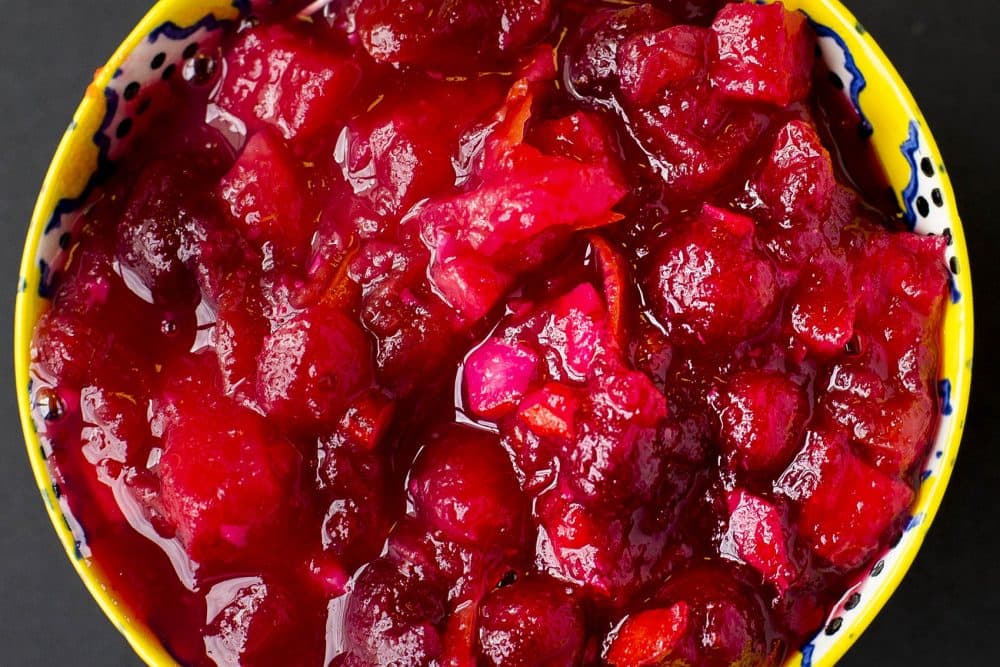
The classic accompaniment to the Thanksgiving turkey, this sauce doubles as a topping for ice cream, pound cake, angel food cake and butter cookies. Try spreading this sweet sauce on your morning muffin or toast, or on top of pancakes and waffles.
The sauce is also the key ingredient in the ultimate, day-after-Thanksgiving turkey sandwich: Spread a few spoonfuls of this sauce onto thick slices of white or wheat toast, with slices of leftover turkey, stuffing and several leaves of crisp lettuce.
Makes about 8 cups.
Ingredients
- 2 cups sugar
- 4 cups water
- 7 cups (24 ounces) fresh cranberries
- 1 cup orange juice, preferably fresh-squeezed
- 6 tablespoons julienned orange zest
- 1/3 cup pure maple syrup
- 3 tablespoons finely chopped fresh ginger
- 1 medium-size pineapple, peeled, cored and diced
- 1 1/2 cups chopped toasted pecans
Instructions
- Mix the sugar and water in a large saucepan and bring to a boil over high heat. Boil for 5 minutes. Reduce the heat to medium and simmer for about 15 to 20 minutes, or until the sugar syrup is somewhat reduced and turns a pale vanilla color.
- Add the cranberries and simmer until they begin to pop, about 5 minutes. Add the orange juice, orange zest, maple syrup, ginger, and simmer over medium heat for about 15 minutes, or until the sauce is somewhat thickened. If the sauce still seems thin, reduce it over medium heat for another 10 to 15 minutes. It will thicken when you add the nuts and the sauce cools, but this is not a very thick sauce.
- Remove from the heat and cool several minutes. Stir in the pineapple and the nuts and let cool to room temperature. Store in a clean glass jar in the refrigerator for up to 10 days, or freeze for up to six months.
Find more sides here and here.
For the vegans
Vegan jeweled rice with roasted vegetables
Want a vegan dish to scream holidays without spending hours preparing? This is an ideal main course for vegans or a great side dish to add to your Thanksgiving table. Basmati rice is cooked with saffron and turmeric (which lends not only a beautiful earthy flavor but a yellow, slightly maroon color to the rice). The cooked rice is then placed in a cake pan and baked.
Meanwhile, an assortment of seasonal autumn vegetables — beets, winter squash, carrots, Brussel sprouts, leeks, etc. — are roasted. You can use any or all of the vegetables listed or add your own favorites like chunks of fennel, turnips, etc. The rice is unmolded from the cake pan and placed in the center of a serving plate, topped with almonds and dried figs sauteed in olive oil and then topped with fresh pomegranate seeds and juice. The dish is a celebration of color, flavor and texture.
Serves 4 to 6 as a main course and 8 as a side dish.
Ingredients
The rice:
- 1 ½ cups basmati rice
- ¼ teaspoon saffron
- ¼ teaspoon turmeric
- 3 cups water
- Pinch salt
The vegetables and topping:
- 2 medium-large red and or yellow beets
- 4 carrots, peeled and cut into 1 inch pieces
- 2 large leeks, dark green section discarded and pale green and white sections cut
- lengthwise, cleared, dried and cut into 1-inch pieces
- 1 ½ to 2-pound winter squash like butternut, buttercup or pumpkin, peeled and with seeds and pulp removed and cut into 1-inch pieces
- 2 cups Brussels sprouts, ends trimmed and left whole or cut in half if large
- 1 red or yellow onion, peeled and cut into large chunks
- ¼ cup plus 2 1/2 tablespoons olive oil
- ½ teaspoon ground cumin
- ½ teaspoon ground turmeric
- Salt and freshly ground black pepper
- 1 cup slivered or chopped almonds
- ½ cup dried figs, chopped
- 1 large pomegranate*
*To prepare the pomegranate, cut it in half and place the fruit side down over a bowl. Tap the skin with a rolling pin or wooden spoon to release the seeds. You may need to squeeze the fruit a bit to release them all. In a separate bowl squeeze the fruit to release all the juice; set aside. You can keep the pomegranate and juice covered and refrigerated overnight.
Instructions
- Make the rice: In a medium saucepan mix the rice, saffron, turmeric, salt and water and bring to a boil over high heat. Reduce the heat to low, stir and cover. Cook for 10 minutes, or until the water is just absorbed. You don’t want to overcook the rice since it will be baked as well. Remove from the heat and cool. The rice can be made several hours ahead of time.
- About an hour before serving: Preheat the oven to 425 degrees. Wrap the beets in foil. Roast the beets for 45 minutes to an hour or until tender when tested with a small sharp knife.
- Place the carrots, leeks, winter squash, Brussels sprouts and onion on one large or two small baking sheets or shallow roasting pans. Toss with the 1/4 cup olive oil, salt and pepper, cumin and turmeric. Roast on the middle shelf for about 30 minutes (put the vegetables into the oven after the beets have roasted for about 30 minutes) or until tender when tested with a small sharp knife.
- Meanwhile, place 1 tablespoon of the oil onto the bottom and sides of a 9 1/2-inch round cake pan. Press the cooked rice into the pan and bake on the middle shelf for about 15 minutes. The rice should go in after the vegetables have roasted for 15 minutes.
- Remove the beets and let cool for 5 minutes. Carefully unwrap and remove the skin from the beets using your fingers or a small sharp knife. Cut the beets into 1-inch pieces and add to the baking sheet with the roasted vegetables.
- While everything is roasting, heat the remaining 1 1/2 tablespoons olive oil in a medium skillet over moderate heat. Add the almonds and cook, stirring, for 2 minutes. Add the figs and salt and pepper and cook, stirring, for another 2 to 3 minutes.
- Carefully unmold the rice in the center of a large serving platter. Surround with the roasted vegetables. Pour the almonds and figs on top of the rice. Sprinkle the pomegranate seeds on top of the rice and vegetables and spoon the pomegranate juice over everything. Serve hot or at room temperature.
And don't forget dessert
Maple crème caramel
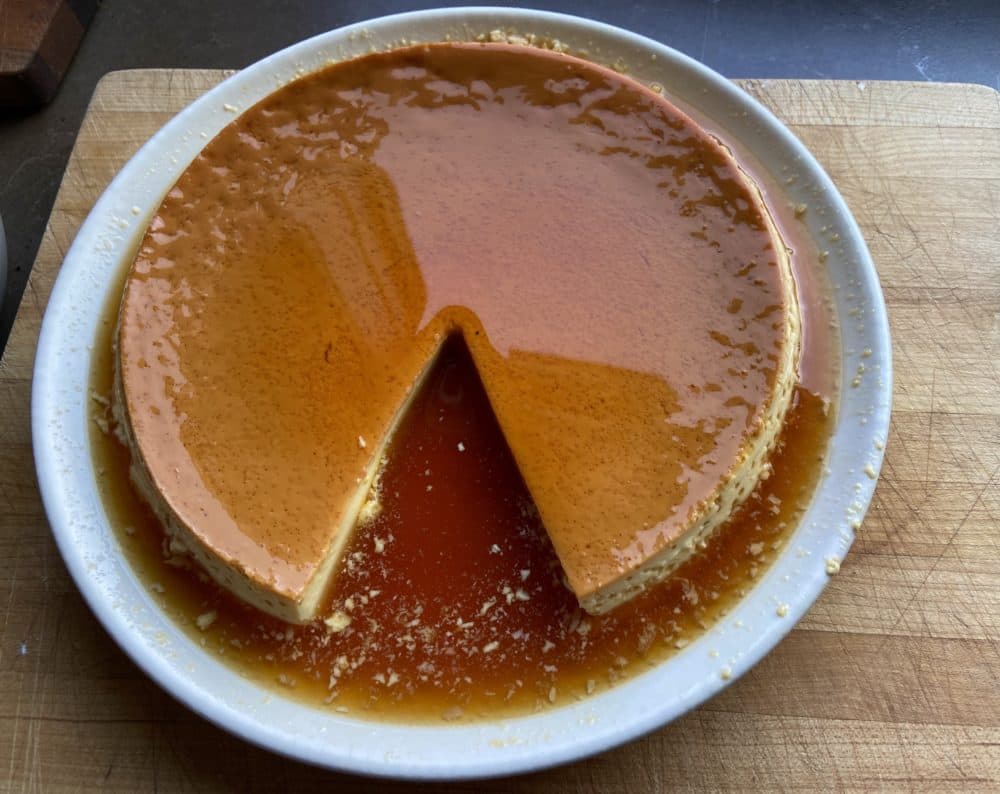
I love the silky smooth texture of this custard. I love the syrupy caramel. And I love the sweet, haunting flavor of the maple. Best of all this dessert needs to sit in the refrigerator overnight, leaving you to relax on the day you serve it.
If you’ve always been fearful of making caramel you can relax. This is a straightforward method that never fails. You can make one large crème caramel in an 8-inch cake pan or make individual portions using 8 six-ounce ramekins.
This recipe is my adaptation of one that appeared in “Fine Cooking” by Tish Boyle.
Serves 8.
Ingredients
The maple caramel:
- ¾ cup sugar
- ¼ teaspoon lemon juice
- ¼ cup water
- ¼ cup maple syrup
The crème caramel:
- 2 cups milk
- 1 cup heavy cream
- 3/4 cup maple syrup
- Pinch salt
- 4 eggs
- 2 egg yolks
- 1 teaspoon vanilla extract
Instructions
- Make the caramel: In a medium saucepan, mix the sugar, lemon juice, water and maple syrup and bring to a boil over medium-high heat. Have a pastry brush ready to wash down the sides of the pan if sugar adheres; this prevents crystallization. Cook for about 8 minutes, swirling the pan once or twice to keep the color even. Cook until the caramel is an even dark (not burnt) amber color. Keep your eye on it; it can burn quickly. Remove from the heat and pour the caramel into the bottom of an 8-inch cake pan or distribute between the bottom of eight 6-ounce ramekins swirling the caramel to evenly coat the bottom of the cake pan or ramekins. Set aside.
- Prepare the crème caramel: Bring a pot of water to boil. Preheat the oven to 325 degrees. Place the cake pan or ramekins into a shallow baking sheet with sides or shallow baking tray.
- In a medium saucepan, mix the milk, cream, maple syrup and salt and place over medium heat. Bring the mixture to a simmer, stirring occasionally. Once it starts to simmer, remove the pan from the heat.
- In a large bowl whisk the eggs, egg yolks and vanilla. Slowly whisk the warm milk mixture into the eggs, adding it bit by bit and whisking continuously. Place a fine strainer over another bowl and strain the mixture. Pour the strained mixture into the cake pan or divide evenly into the ramekins directly on top of the caramel (which should have hardened at this point).
- Pour the boiling water around the cake pan or ramekins, being very careful not to splash any into the custard, adding enough to come up the sides of the pan or ramekins a few inches (not even halfway). Carefully transfer the baking sheet to the preheated oven and bake for about 45 to 50 minutes if it’s in a cake pan and about 30 to 35 minutes in the ramekins. The custard is ready when it appears set and firm along the edges, but when you gently shake the pan or ramekin it’s still a bit jiggly in the center.
- Carefully remove the baking pan from the oven, remove the cake pan or ramekins from the baking pan with the water, and let cool completely on a rack. Once cool, cover and refrigerate for at least 12 hours.
- To serve: Use a flat kitchen knife to work your way around the cake pan or ramekins. Have a serving plate or individual plates (if baked in ramekins) ready and invert the custard onto the plate. Let all the caramel drip out from the bottom. Serve cold.
